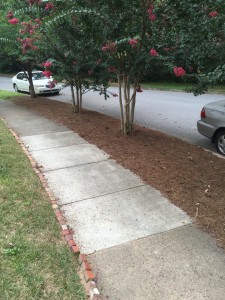City Council Takes First Steps on Sidewalk Ordinance
by Jack White
 As many people know, VHCA and Virginia-Highland property owners made a tremendous investment in sidewalks over the last 2.5 years. This was possible because neighbors and VHCA stepped up financially, and because VHCA was able to bundle over 200 improvements to move the repairs through the city. To this day it is very difficult for individual citizens to repair sidewalks cost-effectively. A daunting wall of permitting red tape is only the first challenge.
As many people know, VHCA and Virginia-Highland property owners made a tremendous investment in sidewalks over the last 2.5 years. This was possible because neighbors and VHCA stepped up financially, and because VHCA was able to bundle over 200 improvements to move the repairs through the city. To this day it is very difficult for individual citizens to repair sidewalks cost-effectively. A daunting wall of permitting red tape is only the first challenge.
The project benefited from a city program that provided sidewalk repairs for about a third of the city’s actual cost, making it a good value for property owners. That program is no longer available, but the process of funding and delivering the repairs focused City Hall’s attention on sidewalk repairs in a new way. While Virginia-Highland still needs more sidewalk work, the improvement is noticeable.
Along the way, VHCA, including Peggy Berg, the Board member who chairs the Safety Committee, got deeply involved in the nuts and bolts in the political challenges involved in improving our sidewalk system citywide. While the neighborhood repair program has ended, the advocacy campaign continues.
In mid-July our City Council unanimously revised the applicable ordinance in several important ways. For the first time, the city has appropriated funds directly for sidewalk repairs, and the Public Works Department is now required to ‘prioritize’ where the greatest needs are. Peggy’s op-ed on the topic in last week’s AJC is linked here.
The initial levels of funding are modest, but there’s now a better chance that monies will be spent on making our sidewalks safe and usable. Over time, this should reduce sidewalk injuries that lead people to sue the city. Settlements of such suits have cost the city several million dollars in the last decade, a fact that was not lost on anyone. An ounce of prevention can save a lot of money.
An immediate task for Public Works under the revised Ordinance is the creation of a prioritization policy, which (in our view) has to be based on a formal sidewalk inventory if repairs are to be planned objectively. Some readers may recall the work of Georgia Tech Civil Engineering professor (and VaHi resident) Randy Guensler and his (then) graduate students Alice Grossman and Zan Frackelton. In 2013 they developed an innovative wheelchair-mounted camera with vibration sensors that videoed and measured the roughness of sidewalks. Whether those results – they have examined about half the city – and that system (or others) are used, a formal inventory and approach to sidewalk management will be critical to thoughtful and effective spending by the city.
The revised law also did not delete the section that formally makes individual owners responsible for their abutting sidewalks. This archaic, unenforced, (and unenforceable) provision remains at odds with existing city practice and the direction of this new ordinance. It needs to be removed, if only for clarity.
These limitations notwithstanding, it’s worth noting that even this first step took a huge effort from Councilman Mary Norwood and faced resistance from the administration. (Please note that Alex Wan’s initial hesitation on this issue concerned the city’s ability to fund the commitments made in the legislation. He supported the final draft as a financially responsible start.)
The director of the pedestrian advocacy group PEDS (an organization to which VHCA has donated for many years, and still does) was disappointed in the final version, calling it insufficient. (Sally Flocks’ op-ed may be read here.) Peggy agrees that much more is needed, but she argued very effectively at Council that passing this bill at least (and at last) put the camel’s nose in the tent. The creation of a framework for future funding and moving toward formal policies were good first steps.
Now we – this ‘we’ is neighborhoods, NPUs, and citizens – need to keep pushing on funding and implementation. It’s particularly important that this program remain a viable and visible item in next year’s municipal budget. On that, almost everyone will agree.
Finally, that VaHi got so many sidewalks repaired was a result of Peggy’s doggedness, the willingness of several successive VHCA Boards to spend (a lot of) money on the matter, support from Councilmember Wan, and deep enthusiasm and financial support for the outcomes from local citizens. The enthusiasm of our own residents to get things done now showed that such repairs were quite practical, especially if approached in an organized manner, and made it a lot harder for City Hall to keep burying the issue.
From a poly sci perspective, our sidewalks are a good example of how effective fundraising, planning, and a targeted public effort can make a real difference. From a practical perspective, it immediately made our neighborhood more walkable for us and our visitors. In even the most optimistic estimate, it will take the City a very long time to start making repairs on their own initiatives in our community.
In the larger context, it is fundamentally unfair that even the partial successes VaHi has enjoyed required a funded civic association, enthusiastic citizens, and the unusual focus and determination that Peggy displayed. Safe, walkable sidewalks are not just for kids and seniors and those who can afford to pay more – every community in Atlanta needs and deserves them. Let’s make it happen.
Jack White is a member of the VHCA Planning Committee and Board.